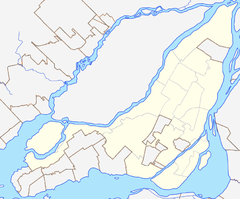Place du Canada
| Place du Canada | |
|---|---|

Place du Canada from René Lévesque Boulevard.
|
|
| Type | Town square |
| Location | Downtown Montreal, Ville-Marie Montreal, Quebec, Canada |
| Coordinates | 45°29′54″N 73°34′08″W / 45.498375°N 73.568917°WCoordinates: 45°29′54″N 73°34′08″W / 45.498375°N 73.568917°W |
| Area | 1.4 hectares (3.5 acres) |
| Created | 1876 (renamed 1967) |
| Operated by | City of Montreal |
| Status | Open all year |
Place du Canada (part of Dominion Square until 1967) is a large urban square in downtown Montreal.
At 14,000 square metres (150,000 sq ft) it is slightly larger than the adjacent Dorchester Square, with a more varied topography due to a downward slope towards De la Gauchetière Street. Place du Canada also differs from Dorchester Square in having manicured, though densely packed, pockets of flora arranged to impede direct lines of sight and diffuse pedestrian traffic. The French term place can roughly be translated as denoting a plaza, which has a different legal definition from squares or parks in Montreal. It is open twenty-four hours per day and is bordered by René Lévesque Boulevard to the North, Peel to the East, De la Cathédrale to the West and De la Gauchetière Street to the South.
Place du Canada was developed along with the present Dorchester Square between 1872 and 1876 and was formally inaugurated that year as Dominion Square. It quickly developed into a prestige address and major transportation hub, with streetcars, cabs, carriages (and by 1889) the Canadian Pacific Railway's Windsor Station at the southwest corner of the plaza. What had once been an informal meeting place and common green would be formalized as a pedestrian traffic corridor, linking the estates and middle class suburbs to the west and northwest with the commercial sector moving up the hill from the southeast. As an urban square, it satisfied two goals; first to provide a method of diffusing transit nodes, and second as an open manicured natural environment to provide rest, recreation and a healthy respite from the cramped industrial and business core immediately south of the area.
After the cholera outbreak of 1851, the area had been the site for several hastily convened cemeteries of various denominations. Beginning in 1854, the City of Montreal began exhuming the bodies from the Saint-Antoine Catholic Cemetery to be relocated to Notre-Dame-des-Neiges Cemetery on the northeast slope of Mount Royal. This allowed for the extension of Dorchester Boulevard (now René-Lévesque Boulevard) to the west and the development of this area. Several large properties were surveyed and offered for sale.
...
Wikipedia

